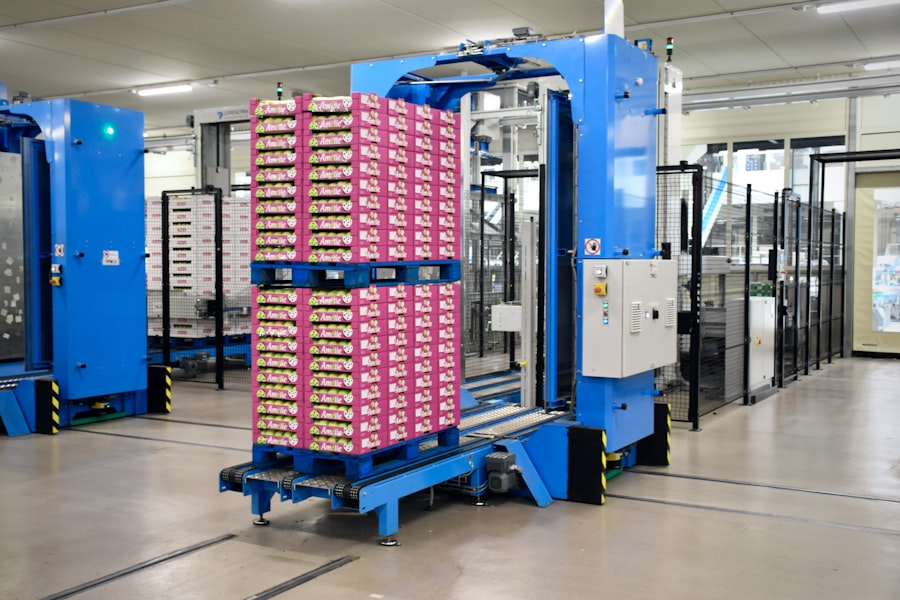Artificial Intelligence (AI) and automation are transforming modern business operations. AI involves machines simulating human intelligence processes, while automation uses technology to perform tasks with minimal human intervention. These technologies offer potential benefits such as streamlined workflows, reduced operational costs, and enhanced decision-making capabilities.
AI and automation applications in business include customer service chatbots, predictive analytics, and robotic process automation. By implementing these technologies, companies can automate repetitive tasks, analyze large data sets, and improve overall efficiency. This allows employees to focus on more strategic and complex responsibilities.
However, integrating AI and automation into business workflows presents challenges and risks that require careful consideration and management. Successful implementation involves understanding the potential benefits, developing appropriate strategies, and addressing potential obstacles. This article will examine the advantages of AI and automation for business workflows, provide guidance on implementation, and present case studies of successful integration.
Additionally, it will explore future trends in AI and automation for business processes and offer insights on how companies can leverage these technologies to enhance their operational efficiency.
Key Takeaways
- AI and automation are revolutionizing business workflows by streamlining processes and increasing efficiency.
- Businesses can benefit from AI and automation by improving decision-making, reducing operational costs, and enhancing customer experiences.
- Implementing AI and automation in business requires careful planning, investment in technology, and employee training.
- Challenges and risks of AI and automation integration include data security, job displacement, and resistance to change.
- Case studies demonstrate successful implementation of AI and automation in various industries, showcasing the positive impact on productivity and profitability.
- Future trends in AI and automation for business workflows include advancements in machine learning, natural language processing, and robotic process automation.
- Leveraging AI and automation can lead to improved business efficiency, competitive advantage, and sustainable growth.
Understanding the Benefits of AI and Automation for Business Workflows
Increased Efficiency through Automation
By automating repetitive tasks, such as data entry, invoice processing, and customer service inquiries, businesses can free up employees to focus on more strategic tasks that require human judgment and creativity.
Improved Decision-Making with AI Analysis
AI can also analyze large volumes of data to identify patterns and trends that humans may overlook, leading to more informed decision-making. Additionally, automation can help businesses reduce errors and improve the accuracy of their processes, leading to higher quality outputs.
Enhanced Customer Experience and Personalization
Furthermore, AI and automation can help businesses improve customer service by providing 24/7 support through chatbots and virtual assistants. These technologies can quickly respond to customer inquiries, provide personalized recommendations, and resolve issues in real-time, leading to higher customer satisfaction. Additionally, AI can help businesses personalize their marketing efforts by analyzing customer data to identify preferences and behavior patterns, leading to more targeted marketing campaigns and higher conversion rates.
Overall, the benefits of AI and automation for business workflows are significant, leading to improved efficiency, reduced costs, and enhanced customer satisfaction.
Implementing AI and Automation in Your Business
Implementing AI and automation in your business requires careful planning and consideration. The first step is to identify the areas of your business that could benefit from these technologies. This could include repetitive tasks that are prone to errors, data analysis processes that are time-consuming, or customer service functions that could be automated.
Once you have identified the areas for implementation, it is important to assess the available technologies and choose the ones that best fit your business needs. Next, it is important to involve key stakeholders in the implementation process to ensure buy-in and support for the new technologies. This could include employees who will be directly impacted by the implementation, as well as senior management who will provide the necessary resources and support.
It is also important to provide training and support for employees who will be using the new technologies to ensure a smooth transition. Finally, it is important to continuously monitor and evaluate the performance of the new technologies to ensure that they are delivering the expected benefits. This could involve collecting feedback from employees and customers, analyzing key performance indicators, and making adjustments as needed.
By carefully planning and implementing AI and automation in your business, you can streamline your operations, reduce costs, and improve efficiency.
Overcoming Challenges and Risks of AI and Automation Integration
While the benefits of AI and automation for business workflows are significant, there are also challenges and risks that must be carefully considered and managed. One of the main challenges is the potential impact on jobs, as automation could lead to job displacement for certain roles. It is important for businesses to consider how they can reskill or upskill employees whose roles may be impacted by automation to ensure a smooth transition.
Another challenge is the potential for errors or biases in AI algorithms, which could lead to incorrect decisions or outcomes. It is important for businesses to carefully evaluate the performance of AI algorithms and ensure that they are fair and accurate. Additionally, cybersecurity risks must be carefully considered when implementing AI and automation, as these technologies could be vulnerable to cyber attacks if not properly secured.
Furthermore, there may be resistance from employees who are hesitant to embrace new technologies or fear that their jobs may be at risk. It is important for businesses to communicate openly with employees about the reasons for implementing AI and automation, involve them in the process, and provide training and support to ensure a smooth transition.
Case Studies: Successful Implementation of AI and Automation in Business Workflows
Several companies have successfully implemented AI and automation in their business workflows, leading to significant improvements in efficiency and cost savings. For example, a global e-commerce company implemented robotic process automation (RPA) to automate order processing, resulting in a 40% reduction in processing time and a 25% reduction in operational costs. This allowed employees to focus on more strategic tasks, such as improving customer experience and expanding into new markets.
Another example is a financial services company that implemented AI-powered chatbots to handle customer inquiries. This led to a 30% reduction in customer service costs and a 20% increase in customer satisfaction scores. The chatbots were able to quickly respond to customer inquiries, provide personalized recommendations, and resolve issues in real-time, leading to higher customer satisfaction.
Additionally, a manufacturing company implemented predictive maintenance using AI algorithms to analyze equipment sensor data and identify potential failures before they occur. This led to a 15% reduction in maintenance costs and a 20% increase in equipment uptime. By proactively addressing maintenance issues, the company was able to reduce downtime and improve overall operational efficiency.
These case studies demonstrate the significant benefits of AI and automation for business workflows when implemented successfully. By carefully planning and implementing these technologies, businesses can streamline their operations, reduce costs, and improve efficiency.
Future Trends in AI and Automation for Business Workflows

AI-Powered Analytics for Informed Decision-Making
One trend is the increasing use of AI-powered analytics to derive insights from large volumes of data. This could help businesses make more informed decisions, identify new opportunities, and optimize their operations.
AI-Powered Virtual Assistants for Streamlined Operations
Another trend is the use of AI-powered virtual assistants for internal business processes, such as scheduling meetings, managing emails, and providing personalized recommendations for employees. This could help businesses improve productivity and streamline administrative tasks.
AI-Powered Predictive Analytics for Supply Chain Optimization
Furthermore, there is a growing trend towards the use of AI-powered predictive analytics for supply chain management. This could help businesses optimize inventory levels, reduce lead times, and improve overall supply chain efficiency.
Additionally, there is a growing focus on ethical AI practices, with businesses increasingly considering the potential impact of AI on society and the environment. This could lead to more responsible use of AI technologies and greater transparency in decision-making processes. Overall, the future trends in AI and automation for business workflows are focused on leveraging these technologies to improve efficiency, make more informed decisions, and drive innovation.
Leveraging AI and Automation for Improved Business Efficiency
In conclusion, AI and automation have the potential to revolutionize business workflows by streamlining operations, reducing costs, and improving decision-making processes. By carefully planning and implementing these technologies, businesses can automate repetitive tasks, analyze large volumes of data, improve customer service, and enhance overall efficiency. However, it is important for businesses to carefully consider the challenges and risks associated with AI and automation integration, such as job displacement, algorithm biases, cybersecurity risks, and employee resistance.
By learning from successful case studies of AI and automation implementation in business workflows, businesses can gain insights into how these technologies can be leveraged to drive significant improvements in efficiency. Looking towards the future, businesses can expect several trends in AI and automation that will shape the way they operate, such as increased use of AI-powered analytics, virtual assistants for internal processes, predictive analytics for supply chain management, and a focus on ethical AI practices. Overall, by embracing AI and automation in their business workflows, companies can position themselves for success in an increasingly competitive marketplace by improving efficiency, reducing costs, enhancing decision-making processes, and ultimately driving innovation.
If you’re interested in learning more about how AI and automation can improve your business workflows, you might also want to check out this article on AWS Elastic Beanstalk CI/CD Pipeline with Docker Containers. This article discusses how using AWS Elastic Beanstalk and Docker containers can streamline your development and deployment processes, ultimately leading to more efficient business workflows.
FAQs
What is AI and automation?
AI, or artificial intelligence, refers to the simulation of human intelligence processes by machines, especially computer systems. Automation, on the other hand, involves the use of technology to perform tasks with minimal human intervention.
How can AI and automation benefit business workflows?
AI and automation can benefit business workflows by streamlining processes, reducing human error, increasing efficiency, and allowing employees to focus on more strategic tasks. They can also provide valuable insights and data analysis to improve decision-making.
What are some examples of AI and automation in business workflows?
Examples of AI and automation in business workflows include chatbots for customer service, predictive analytics for sales forecasting, robotic process automation for repetitive tasks, and natural language processing for data analysis.
What are the potential challenges of implementing AI and automation in business workflows?
Challenges of implementing AI and automation in business workflows may include initial costs, integration with existing systems, employee resistance to change, and potential job displacement. It’s important for businesses to carefully plan and manage the implementation process.
How can businesses get started with AI and automation in their workflows?
Businesses can get started with AI and automation in their workflows by identifying areas that could benefit from these technologies, conducting thorough research, and seeking out reputable vendors or consultants for guidance. It’s also important to involve employees in the process and provide adequate training.






